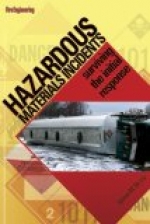Tab Article
First responders who arrive on the scene of a hazardous materials incident may be assigned to an engine, ladder truck, rescue, or ambulance with very little sophisticated HAZMAT equipment. Despite these limitations, their actions during the initial response will often set the stage for the success or failure of the entire event.
Many incidents start out as minor “routine” events that suddenly escalate when something goes terribly wrong! First responders, despite their best intentions, can quickly become part of any hazardous materials problem. The results can be first responders who are killed or seriously injured, or those who suffer devastating illnesses years after exposure to a hazardous material.
In Hazardous Materials Incidents: Surviving the Initial Response, author Steven M. DeLisi shares his years of experiences in a practical, easy-to-read manner. Even if you have hours of training on hazardous materials response, this book will provide every reader with…
• Practical advice based on the real-life experiences of first responders
• A one-stop source on topics such as atmospheric monitors and class B foam
• Steps to managing “routine” incidents to prevent them from becoming disasters
• Limitations of federal hazardous materials regulations you need to know
• Real-world examples of first responders who won (or lost) the battle with hazardous materials


